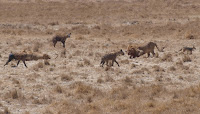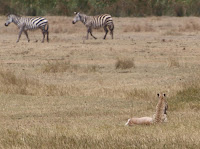
Kenya has 42 tribes, with the Maasai in their traditional red shuka probably being the most recognized to those from outside of East Africa. Maasai are also found in Tanzania especially in the Ngorongoro Conservation Area and surrounding land. We saw a lot of Maasai herdsmen as they moved their cows and goats throughout the countryside in search of pastures for their livestock to graze. I do not believe that throughout our 12 day safari while moving between parks, there was not a single day that we didn't witness the migration of the Maasai with their herd.
Their existence is a poor one by most standards, measured in their culture by the number of cows, goats and children they have. Practicing polygamists, many have multiple wives and households. Prearranged marriages are the norm, with girls being "given" as early as age 10. Her family will receive gifts from the man's family, in the form of livestock.

Boys become men at the age of 14 through a ritualistic practice that includes public circumcision followed by up to three months away with others donning black clothing and white face paint. When they return, they are of age to consider taking a wife, although most will wait until late teens. During our time passing through the Ngorongoro Conservation Area, we saw several groups of these young men.

While in the Maasai Mara, our guide arranged for us to make a visit to the neighboring Maasai Village (for a price of $25/person). We were met by one of the tribe's elder warriors, who served as our guide throughout their village. A group of Maasai greeted us by performing their ceremonial Welcome Dance, followed by the women's greeting.

(You can see "us" in this photo with the ladies.)
The men demonstrated how they make fire, the old fashioned way like you did in scouts, by rubbing sticks together over highly flammable straw. We were also shown how they make and maintain their houses using cow dung and water. The thatch roofs are also maintained and transported from location to location when the tribe migrates away from this particular village in search of better pastures for their cattle.
At the center of their village were two large areas, fenced in and enclosed using sticks, for their cows and goats. Kept separate at night, there is always a warrior standing guard to protect against attacks from lions. While this particular tribe does not seek to kill the lions, they will do so if necessary in defense of their homes, families or livestock. Other Maasai tribes, however, are not so kind to the lions as they still practice old rituals that include hunting and killing lions, which by tradition is necessary to demonstrate warrior qualities.

The Maasai people seemingly depend on the tourism to the area in support of their financial needs which include outside medical services and clothing. Wherever we went, there was a constant reminder of their poverty whether through the aggressive attempts to sell their beaded jewelry or wood carvings, or the outright begging for money at park entrances. Even the privilege of taking their photo is a means that they use to generate cash from tourists. Check out the dollar bills in the hands of the young black-clad men above!
Many of the lodges we stayed at employ the Maasai as porters, servers and in other service staff positions. More often than not, they wore uniforms of the resort although some resorts did have traditionally attired Maasai around on the property. I personally got a kick out of the one at Oltukai Lodge (Amboseli Nat'l Park - Kenya) whose job it was to chase away the annoying monkeys using a slingshot.
In talking with workers at some of the lodges, it became clear that doing so was at great inconvenience to the employees and their family. One young man named Joseph supported his one wife and two kids through employment with a lodge. He told how he lives on site for two months at a time, being allowed to return home for about two weeks, before having to report back to work again for another two month cycle.
During his work cycle, his hours are generally 5:00a until 10:00p, seven days a week with no time off until his return home to his family. While this requires much sacrifice, he explained to us that this is necessary if he wants to provide for his family and to pay to send his children to a decent (private) school. While there is "government school" (aka public school), he told of poor learning conditions which he felt was not good enough for his kids.
I also learned from a young single Maasai mom that the Maasai lifestyle is not necessarily embraced by all who are born into the tribe. She was the eldest of three children. Her father wished better for her, so he has refused to "sell her" to wed within the tribe. She went to school to learn cosmetology and is employed by a lodge as a masseuse and manicurist.
She told of how poorly the Maasai men treat their women and that her father wanted better for her and her younger sisters. While they still live on Maasai land, it is only through the grace of the tribe as her uncle is one of the tribes most senior elders.
As an employee of a lodge many hours from her village, she rides the bus over four hours to work. Once there, she works for six weeks straight doing a variety of duties as necessary. Her break to go home to her three year old son lasts only eight days, at which time she must return to the lodge for another six weeks.

Some of the lodges offered evening entertainment provided by the local Maasai, often through song and dance. For those who did not have an opportunity to visit a local village, this was a great opportunity to take photos of the Maasai in their traditional clothing. Check out the video below of the Maasai Dance taken at the Ngorongoro Sopa Lodge (Tanzania).
I could not help but to feel that these people, while trying to work to earn a living in support of their families, are little more than slaves to the tourism industry. Reports of poor wages and being largely dependent on tips add to my perception in that regard. That said, they are to be respected for doing what they can in order to earn a living in hopes of creating a better life for future generations of Maasai.
 Well I think this will be my final post of this blog. I've been home for a week and the jet lag seems to have finally subsided. I'm going to bed and waking up around my usual times, so that has been much welcomed over the past couple of days.
Well I think this will be my final post of this blog. I've been home for a week and the jet lag seems to have finally subsided. I'm going to bed and waking up around my usual times, so that has been much welcomed over the past couple of days.
 Eventually, another did catch and take the food away. Curiously, that was the end of the chase as if pack leader, alpha dog was in possession of the food. It went off in an opposite direction to feast on the spoils of victory.
Eventually, another did catch and take the food away. Curiously, that was the end of the chase as if pack leader, alpha dog was in possession of the food. It went off in an opposite direction to feast on the spoils of victory.






























 Some of the lodges offered evening entertainment provided by the local Maasai, often through song and dance. For those who did not have an opportunity to visit a local village, this was a great opportunity to take photos of the Maasai in their traditional clothing. Check out the video below of the Maasai Dance taken at the Ngorongoro Sopa Lodge (Tanzania).
Some of the lodges offered evening entertainment provided by the local Maasai, often through song and dance. For those who did not have an opportunity to visit a local village, this was a great opportunity to take photos of the Maasai in their traditional clothing. Check out the video below of the Maasai Dance taken at the Ngorongoro Sopa Lodge (Tanzania).


 For me, I didn't find much time for relaxation poolside, however, as I did not skip any of the afternoon game drives in favor of swim time. Others in my group did however enjoy the opportunity to do so.
For me, I didn't find much time for relaxation poolside, however, as I did not skip any of the afternoon game drives in favor of swim time. Others in my group did however enjoy the opportunity to do so.

